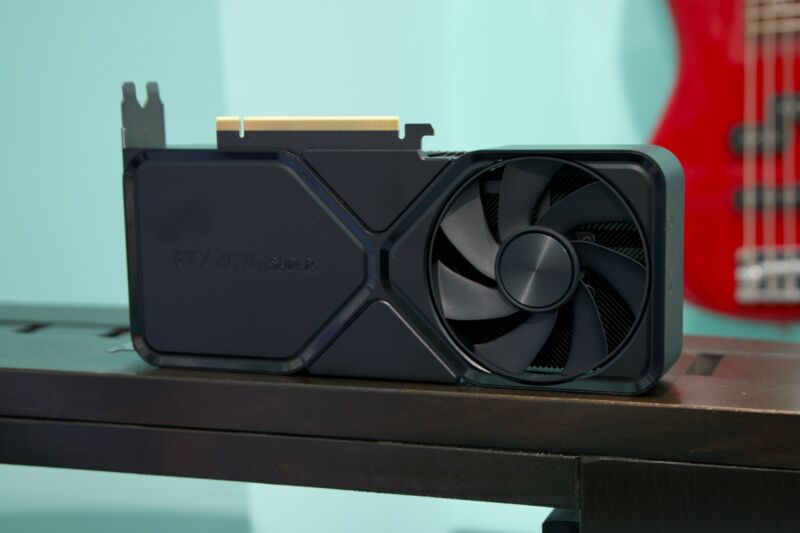
Judging by the comments on YouTube reviews, you'd think Nvidia's RTX 4070, launched in April 2023 for $599, was a terrible graphics card. The reaction wasn't as brutal as it was among commenters and reviewers for the 4060 Ti a month later (a "waste of sand," declared Gamers Nexus), but you'd usually find praise for its power efficiency but criticism of its price (high for a xx70 card) and its performance improvement relative to the previous generation (only about as fast as an RTX 3080, sometimes less).
Those are all largely valid criticisms. But the 4070 is Nvidia's most popular RTX 4000-series desktop GPU, at least according to the (admittedly flaky and opaque) Steam Hardware Survey data for December 2023. It's not in the top 10—this is dominated by older midrange GeForce cards that have been out a lot longer—but it's doing better than Nvidia's other 40-series desktop cards and better than every one of AMD's RX 7000-series cards put together.
The release of the RTX 4070 Super should help bring the enthusiast commentariat version of reality and the Steam Hardware Survey's version of reality into closer sync with one another. At the same $599 price—still more than the $499 of the 2070 Super or 3070, but not higher than the 4070—you get performance that Nvidia says is more in line with the RTX 3090. And the power efficiency remains quite impressive, though power use overall is up just a bit from the regular 4070.
It's still hard to swallow a graphics card that costs more than an entire Xbox Series X or PlayStation 5, a GPU that can easily cost just as much as the entire rest of your PC tower combined. The 4070 Super also needs to contend with AMD's Radeon 7800 XT, which is often as fast or faster, has an additional 4GB of memory, and can often be had for as little as $510. But there's still no card that's offering quite this combination of efficiency and performance. In 2024's GPU market, where stubbornly higher prices are an enduring hangover of the 2020–2021 GPU shortage, a significant performance bump for a not-even-year-old card that's available for the same price counts as a win.
Meet the RTX 4070 Super
-
The 4070 Super Founders Edition is black with black highlights, removing the silver highlights from the regular 4070.Andrew Cunningham
-
The standard array of DisplayPort and HDMI outputs.Andrew Cunningham
The thing that makes the 4070 Super super is the addition of 1,280 extra CUDA cores, a nearly 22 percent increase from the regular 4070. That's more of an increase in computing power than the 4080 Super or 4070 Ti Super saw, both in absolute core counts and expressed as a percentage. That doesn't always mean a 22 percent bump in-game performance, but it's a nice uplift, and it's a whole lot closer to the AD104 GPU die's maximum core count of 7,680.
| RTX 4090 | RTX 4080 | RTX 4080 Super | RTX 4070 Ti | RTX 4070 Ti Super | RTX 4070 | RTX 4070 Super | |
|---|---|---|---|---|---|---|---|
| CUDA Cores | 16,384 | 9,728 | 10,240 | 7,680 | 8,448 | 5,888 | 7,168 |
| Boost Clock | 2,520 MHz | 2,505 MHz | 2,550 MHz | 2,610 MHz | 2,610 MHz | 2,475 MHz | 2,475 MHz |
| Memory Bus Width | 384-bit | 256-bit | 256-bit | 192-bit | 256-bit | 192-bit | 192-bit |
| Memory Clock | 1,313 MHz | 1,400 MHz | 1,437 MHz | 1,313 MHz | 1,313 MHz | 1,313 MHz | 1,313 MHz |
| Memory size | 24GB GDDR6X | 16GB GDDR6X | 16GB GDDR6X | 12GB GDDR6X | 16GB GDDR6X | 12GB GDDR6X | 12GB GDDR6X |
| TGP | 450 W | 320 W | 320 W | 285 W | 285 W | 200 W | 220 W |
The only other specs that really change are cache, which is boosted from 36MB in the 4070 to 48MB in the 4070 Super, and the total graphics power (TGP) of the card, which can now reach a maximum of 220 W. It's a small enough difference that Nvidia's required power supply wattage remains the same at 650 W.
The 4070 Super retains the same 192-bit memory interface and 12GB bank of memory as the regular 4070, and memory and GPU core clocks are all the same, too. For this review, we tested the Founders Edition version of the card, which conforms to Nvidia's default specs and uses the 12VHPWR connector, but cards from Nvidia's partners can come with mild overclocks and 8-pin power connectors. The included 12VHPWR adapter only needs two 8-pin connectors attached, or you can connect it directly to a compatible power supply; ATX 3.0 supplies support 12VHPWR natively, but I recently bought an adapter cable for my gaming PC's modular Cooler Master PSU that plugs directly into the 8-pin connectors on the power supply; you've got more options now than you did a year ago, now that the 40-series has been around for a bit.
Nvidia's Founders Edition card is the same size and shape as the old 4070, which means that (unlike the 4080 and 4090 Founders Edition cards and a whole bunch of triple-fan, triple-slot third-party cards) it ought to fit in just about anything without much hassle, including most mini ITX builds. The only real design difference is that the silver highlights have been swapped out for black ones, giving the card a more imposing "this is my final form" aesthetic. Similarly, we'd expect most of Nvidia's partners to continue using their 4070 card designs without many changes.
reader comments
189